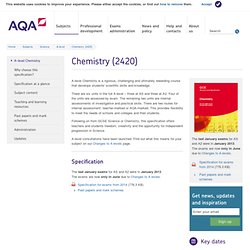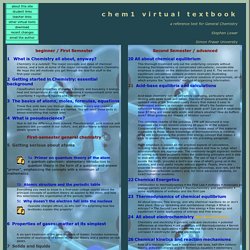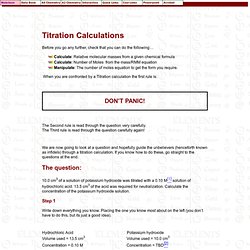

Video Clips. YouTube - Broadcast Yourself. Jason Reid. AQA A-level. A-level Chemistry is a rigorous, challenging and ultimately rewarding course that develops students' scientific skills and knowledge.

There are six units in the full A-level – three at AS and three at A2. Four of the units are assessed by exam. The remaining two units are internal assessments of investigative and practical skills. There are two routes for internal assessment: teacher-marked or AQA-marked. This provides flexibility to meet the needs of schools and colleges and their students. Following on from GCSE Science or Chemistry, this specification offers teachers and students freedom, creativity and the opportunity for independent progression in Science.
A-level consultations have been launched. The last January exams for AS and A2 were in January 2013.The exams are now only in June due to Changes to A-levels. AQA GCE A2 Advanced A Level CHEMISTRY syllabus-specification 2421, past papers exam practice questions links, Unit 4 CHEM4 Kinetics, Equilibria and Organic Chemistry, Unit 5 CHEM5 Energetics, Redox and Inorganic Chemistry, Unit 6 CHEM6 Investigative and P. A level chemistry. Creative Chemistry AS and A Level Stuff. RSC resources. Practical Chemistry. This website is for teachers of chemistry in schools and colleges.

It is a collection of experiments that demonstrate a wide range of chemical concepts and processes. Some of the experiments can be used as starting-points for investigations or for enhancement activities. Many have links to carefully selected further reading and all include information and guidance for technicians. Chemistry is a practical science. Practical activities are not just motivational and fun: they also enable students to apply and extend their knowledge and understanding of chemistry in novel investigative situations, which can aid learning and memory and stimulate interest.
We have published a new set of resources to support the teaching of practical science for Key Stages 3-5. Chemistry Virtual Textbook. Acid-base chemistry can be extremely confusing, particularly when dealing with weak acids and bases.

This set of lessons presents an updated view of the Brønsted-Lowry theory that makes it easy to understand answers to common questions: What's the fundamental difference between a strong acid and a weak acid? Can acid A neutralize base B? Why are some salts acidic and others alkaline? How do buffers work? What governs the shapes of titration curves? This complete rewrite of the previous 1996 pdf document is now organized into seven lessons covering all aspects of the subject. Much emphasis is placed on the practical aspects of calculations, including how to deal with quadratic equations and how to judge when approximations are appropriate. Dynamic Periodic Table. Molarity Calculator. Titration Calculations. Before you go any further, check that you can do the following… Calculate: Relative molecular masses from a given chemical formula Calculate: Number of Moles from the mass/RMM equation Manipulate: The number of moles equation to get the form you require.

When you are confronted by a Titration calculation the first rule is: The Second rule is read through the question very carefully. The Third rule is read through the question carefully again! We are now going to look at a question and hopefully guide the unbelievers (henceforth known as infidels) through a titration calculation. The question: 10.0 cm3 of a solution of potassium hydroxide was titrated with a 0.10 M solution of hydrochloric acid. 13.5 cm3 of the acid was required for neutralization. Step 1 Write down everything you know. Hydrochloric Acid Potassium hydroxide Volume used = 13.5 cm3 Volume used = 10.0 cm3 Concentration = 0.10 M Concentration = TBD Step 2 Write the equation or as much as you know about it.
Step 3 Step 4 Questions. TES Chemistry resources,